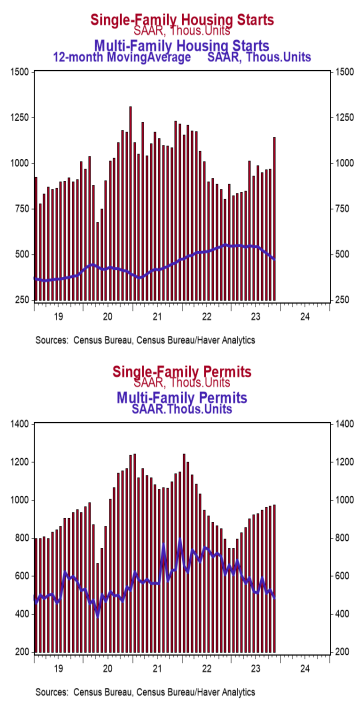- Housing starts increased 14.8% in November to a 1.560 million annual rate, easily beating the consensus expected 1.360 million. Starts are up 9.3% versus a year ago.
- The gain in November was mainly due to single-family starts, while multi-unit starts rose, as well. In the past year, single-family starts are up 42.2% while multi-unit starts are down 33.1%.
- Starts in November rose in all major regions.
- New building permits declined 2.5% in November to a 1.460 million annual rate, slightly below the consensus expected 1.465 million. Compared to a year ago, permits for single-family homes are up 22.8% while permits for multi-unit homes are down 20.3%.
Implications: Housing starts surged well above expectations in November, rising 14.8% and crushing even the most optimistic forecast from any economics group. While one month doesn’t make a trend, housing starts now sit at a six-month high, a sign that developers may have finally found their footing in what has been a challenging environment. While 30-year mortgage rates remain above 7%, they have been on a downward trajectory since peaking above 8% at the end of October. Given the new short-term interest rate projections the Federal Reserve released last week – where the median forecast was 75 bps of rate cuts in 2024 and not a single policymaker had short term interest rates higher a year from now than they are today – we expect mortgage rates to continue trending downward in 2024, providing a tailwind for sales activity. Looking at the details of today’s report, gains were broad-based with all four major regions and both single-family and multi-unit starts contributing. Housing permits declined 2.5% in November, but the drop was entirely due to permits for multi-units (-8.5%). Notably, permits for single-family homes have increased every month since the beginning of 2023. In the past year, the number of single-family starts is up 42.2% while multi-unit starts are down 33.1%. This huge gap in the data is due to the unprecedented nature of the last three years since COVID began. Looking at the big picture, a combination of extremely low interest rates and pressure to work from home led to a big migration to the suburbs (and beyond) and high demand for single-family homes. Then the economy reopened, causing many people to flock back to cities, sparking a boom in apartment projects. Currently, the number of multi-unit properties under construction is hovering near record levels, going back to 1970, when records began. Now it looks like the move back to the cities has petered out leaving a glut of apartments. Meanwhile, owners of existing homes are hesitant to list their properties and give up fixed sub-3% mortgage rates, so many prospective buyers have turned to new builds as their best option. While we don’t see housing as a major driver of economic growth in the near term, recent numbers are certainly not what you’d expect to see if there was a severe housing bust like the 2000s on the way, either. In other recent housing news, the NAHB Housing Index, a measure of homebuilder sentiment, rose to 37 in December from 34 in November. A reading below 50 signals that a greater number of builders view conditions as poor versus good.





